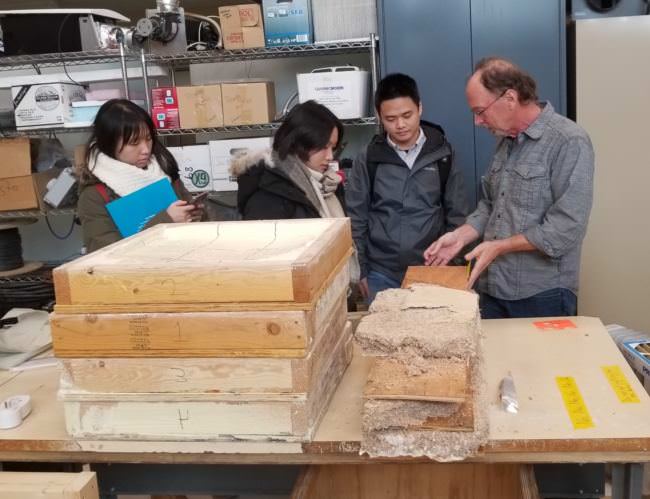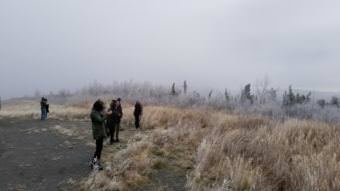
When a group of architecture students from the University of Virginia’s Arctic Design Group came to tour Alaska, one of the first stops was the Anchorage Museum, a building packed with exquisite northern artwork blending style with function. As part of the museum’s September Design Weekend, UVA assistant architecture professor Matthew Jull delivered a lecture about northern design and how, at least in some parts of the world, it is done right.
The next morning, as the students stood in the rain in downtown Anchorage, they confessed that their first impressions of Alaska’s biggest city produced something of a letdown.
“I expected it to be much different than anywhere I’d seen before. But if you take away the beautiful mountains in the backdrop, you could find yourself thinking you’re in another place,” said Michael Tucker of Richmond, one of the 14 UVA students on the Alaska trip.
Sihan Lai, a graduate student from China, said Anchorage’s mountain backdrop and its auto-dominated sprawl reminded her of Albuquerque – and evoked nothing about the far north or the Arctic.
“When I first arrived and I was standing on the street, I want something to remind me we are in Alaska, we are not in someplace else,” she said, after she and her colleagues took a walking tour of downtown Anchorage.
Imported southern design in the far north is a common legacy, Jull said, and so are associated problems.
Examples are familiar to longtime Alaskans. In rural areas, cabins slump into the sunken ground, the end result of construction by newcomers who did not understand the thermal dynamics of permafrost. In midtown Anchorage, there was the long and exposed front staircase at the main public library, an entryway that inevitably turned treacherously icy in winter. It has just now been replaced in a major building renovation.
Now climate change is making northern design even more complicated.
Jull and his wife, UVA assistant landscape architecture professor Leena Cho, established the Arctic Design Group in 2012. Their mission is planning for people’s needs in a way that is responsive to their culture, geographic setting and extreme climate.
The latter is changing quickly, as Alaska and the Arctic are warming at least twice as fast as the rest of the world. Climate change has made the Arctic Design Group’s work more urgent; some popular building and urban designs are no longer adequate.
Much of the group’s work to date has focused on the European Arctic, so Alaska is a new challenge, Jull said.
“Even though the Arctic Design Group has been working in the Arctic region for several years, Alaska is a new place for us. We’re hoping to contribute to the conversations that have been going on here,” he said.
The students have already taken on one Alaska project- the theoretical redesign of a relocated Shishmaref – a potential new and more inland home for Inupiat residents who are expected to leave the village’s current site on the rapidly eroding Chukchi Sea coast. The class project, informed by study from afar of food needs, environmental conditions and culture, produced a variety of suggestions. Among them: new houses designed so that they can be heated by section, reducing energy costs; a community food storage site; and a modular design for a local school that would also serve as a community center.
That work was done before the students set foot in Alaska. The 10-day trip, which took the group to Anchorage, Fairbanks, the Athabascan village of Minto and the Inupiat hub of Utqiagvik, “opened a lot of people’s eyes,” Jull said.

Arrival in Utqiagvik, the northernmost U.S. community, coincided with the town’s first major fall storm, putting the UVA group face-to-face with the effects of climate change.
What greeted them were “horizontal blowing wind, 30 miles an hour, 35 miles an hour, ocean waves, major, major erosion going along the shoreline,” Jull said. “For us, that really was the first clear indication of what we read about.”
The storm made an impression on Claire Casstevens, an Arctic Design Group research associate.
“We got there and the wind’s howling and then it’s snowing, it’s sleeting and the ocean’s going crazy. There are whitecaps,” she said.
Such storm-driven floods have become regular features of a new type of fall season on the North Slope. In past years, sea ice served as a protective barrier, keeping ocean waves in check during fall. Now that ice is no longer near the shore. With hundreds of miles of open water separating Utquigvik from the shrunken ice pack, fall winds are sending surges of floodwater onto land.
Fall flooding has become so routine that one beachside road is written off as unusable during the season, and local authorities have created a makeshift beach berm, composed of dirt, rocks and containers, that they replenish as needed.
There are mixed feelings about the berm, Jull and the students learned. Some people want it strengthened and made more permanent; others dislike it because it blocks the beach, a place they want and need to go at times.
That poses a new challenge that Jull and the students might tackle: Is it possible, to design something that will serve the flood-fighting functions of a berm while allowing people free access to the beach?
Other important lessons came from tribal officials and from the nonprofit Cold Climate Housing Research Center in Fairbanks. Jull said he and the students were impressed with the innovations already happening.
“There’s so much brilliant work being done on wall segments and sanitation systems and water systems,” he said. “How can there be an architecture that emerges from that?”
In an Instagram post made during the trip, student Courtney Sigloh said architecture can provide some answers. The land and cultures are beautiful, she said in the post, but people’s basic needs are not being met. “People live in homes with giant cracks in their doors and no running water, where piles of `trash’ are common and shipping containers are a hot commodity. It is easy to be overwhelmed by the situation, but it was encouraging to feel like architecture had the capacity to make a difference there,” she said.
